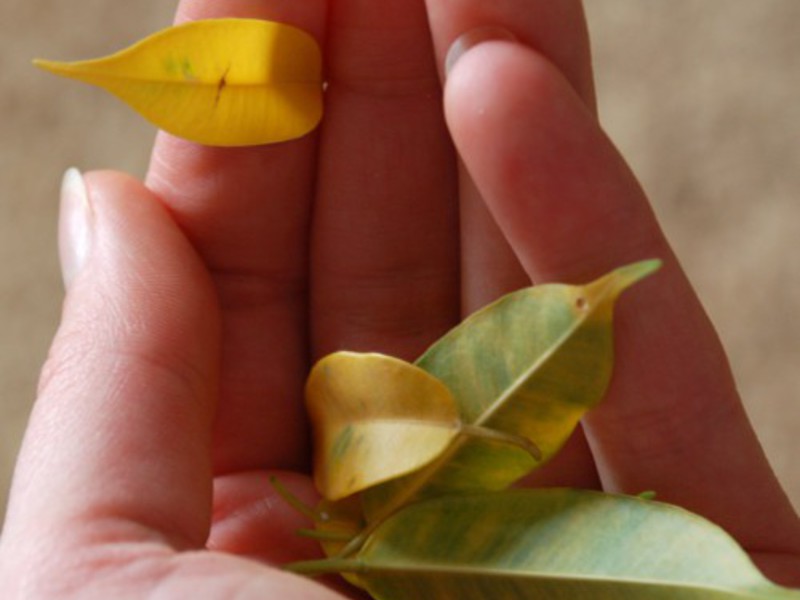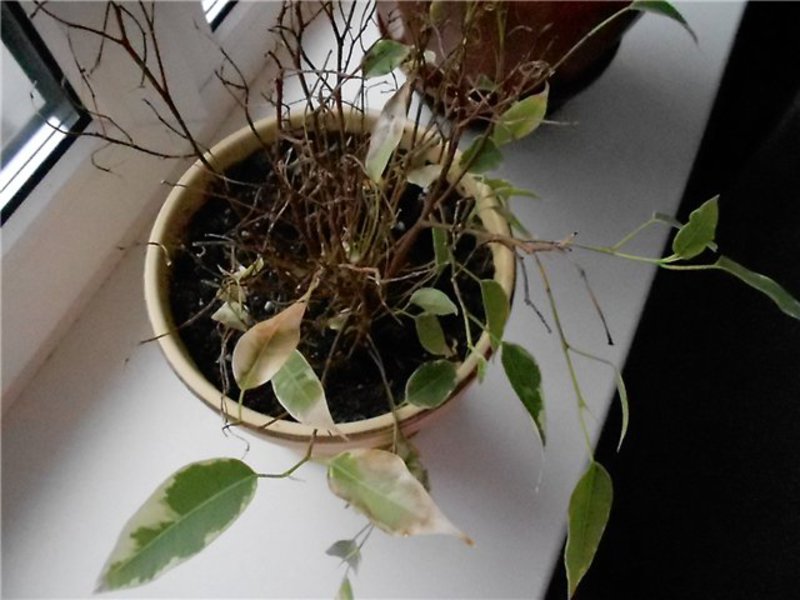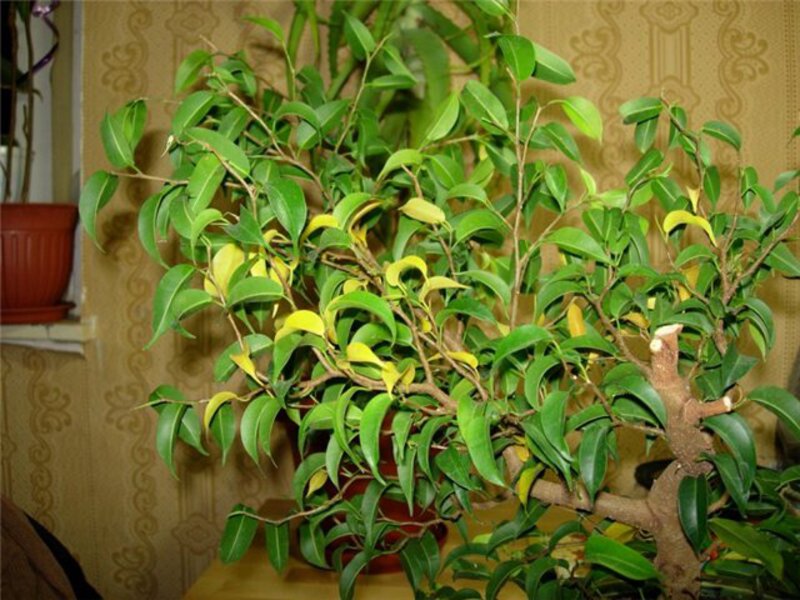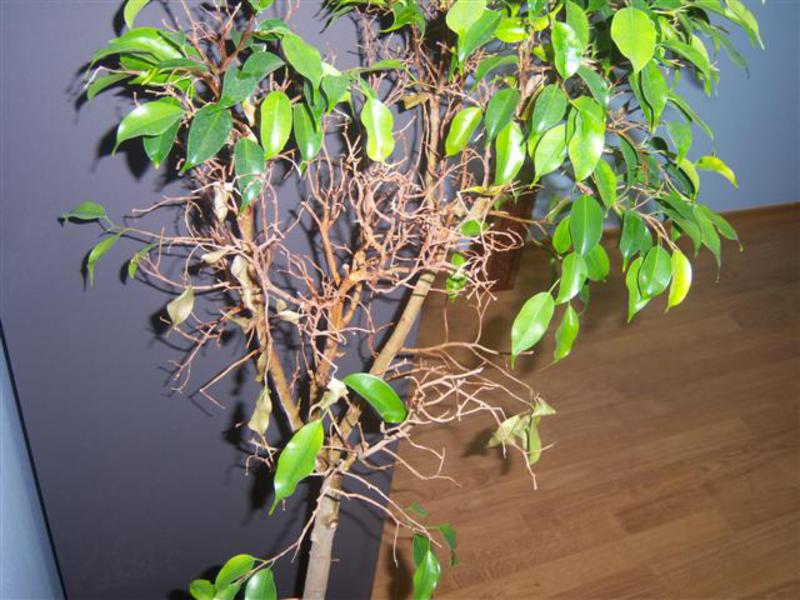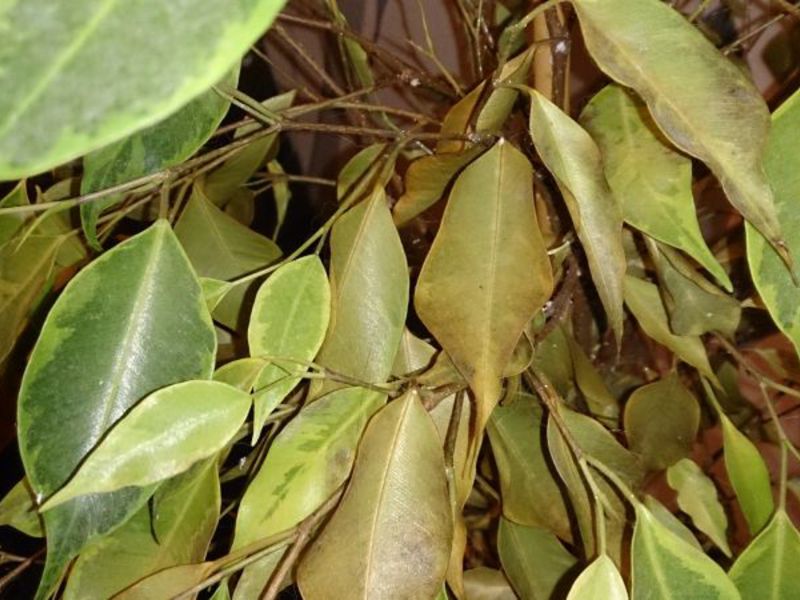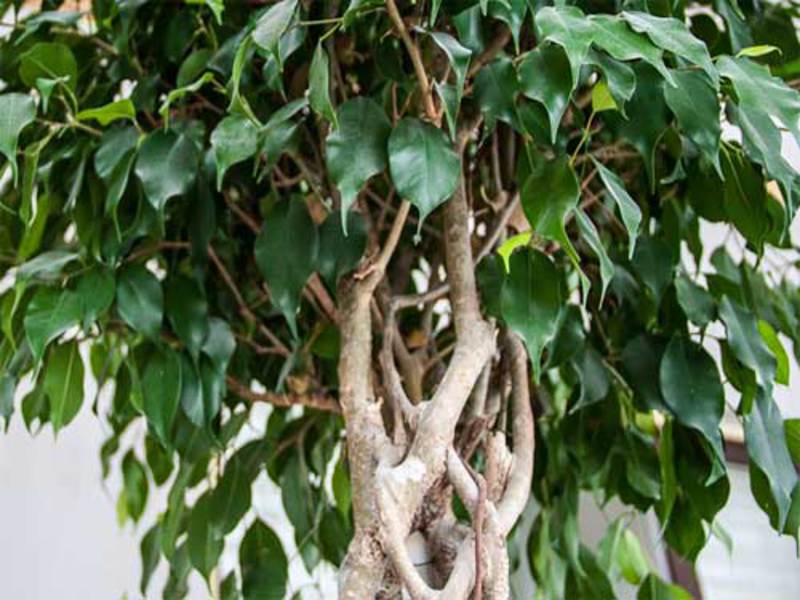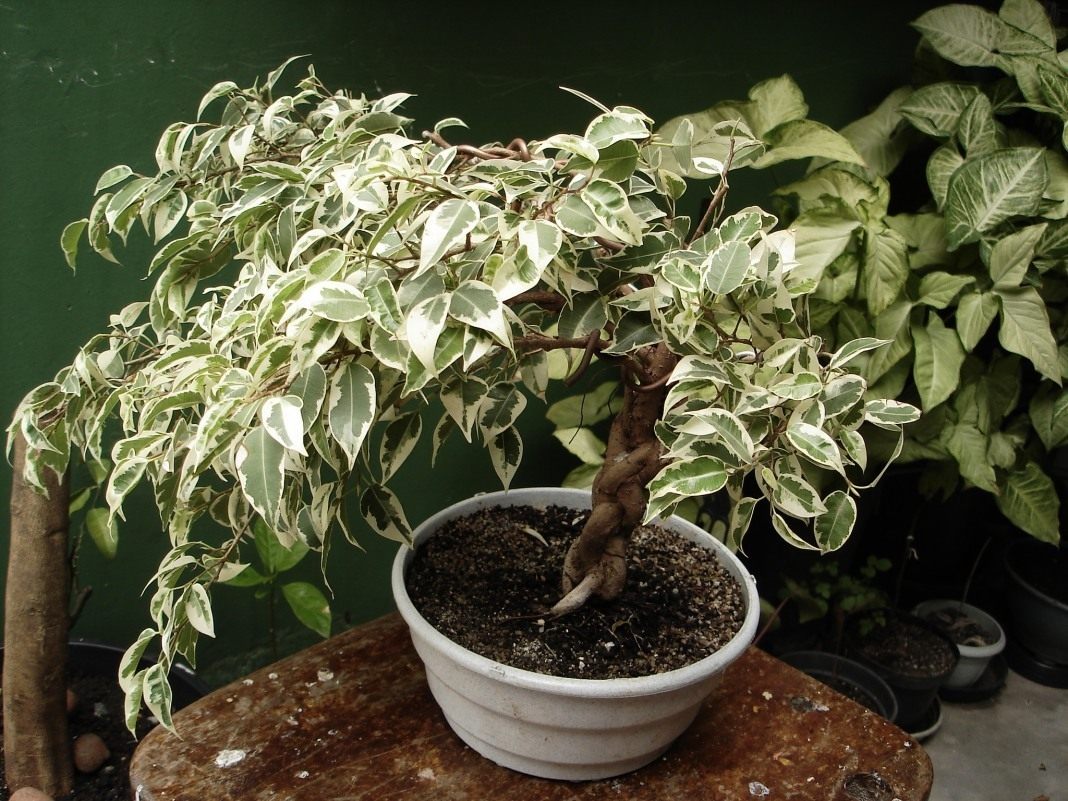Ficus Benjamin is a popular houseplant. Many growers fell in love with him for a wide variety of varieties and a beautiful view. True, this flower is very capricious, moreover, it is picky in care. For example, it sheds leaves more often than other domestic plants, since these lateral shoot organs, despite their attractiveness, are weak and do not tolerate negative environmental influences.
Content
When not to worry?
Ficus brilliant, like other small-leaved plants, can shed some leaves during the winter and fall months. You should not worry about this, if the opal is not more than 10 piecesas a rule, new leaves will appear instead of them in spring.
Why do the leaves crumble and turn yellow?
Watering errors
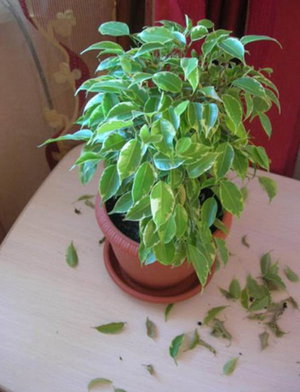 However, if the leaves began to fall off at another time of the year, or their number exceeds the norm, then you need to pay attention to watering. It is this mistake in caring for Benjamin's ficus at home that often leads to leaf fall. To eliminate such a problem, you need to accurately calculate how much water will be just right for a picky plant.
However, if the leaves began to fall off at another time of the year, or their number exceeds the norm, then you need to pay attention to watering. It is this mistake in caring for Benjamin's ficus at home that often leads to leaf fall. To eliminate such a problem, you need to accurately calculate how much water will be just right for a picky plant.
From too frequent watering in ficus root rot may occurwhich leads to weakening and shedding of leaves. But insufficient soil moisture is also dangerous for him, because when trying to preserve the woody part and roots due to lack of water, the plant begins to get rid of the leaves. Of course, after several waterings it will recover, but it will overgrow with leaves for a long time.
To avoid such mistakes in caring for ficus, you must constantly control soil moisture... The soil between waterings should have time to dry out at least 1.5 cm deep from the surface. If the plant is adult, then it is better even by 3 cm. In winter, it is recommended to moisten the Shiny ficus once a week. In general, the colder it is in the room, the less watering is required. By the way, you only need to use warm water for this.
When yellowing of young leaves is observed on a ficus, then most likely the reason is a lack of iron. In this situation the plant can be fed:
- Ferrovit;
- Iron chelate.
In this case, the soil in the pot must be moist. For example, you can first water the ficus, and the next day start feeding.
Even in the winter months, this tropical plant begins a dormant period. Due to the lack of sunlight in the leaves, photosynthesis is suspended, the roots cease to absorb water, as in the summer, so it is better to reduce watering. It happens that Benjamin's ficus leaves are strong shrink and curlbut do not lose their green color.
In addition, leaf fall near the tree can occur due to drafts and cold air, so the pot with it should be placed away from windows or balcony blocks.
Temperature regime
This plant thrives at 18-25 degrees.If it becomes too hot and stuffy in the room where it is located, the leaves begin to lose turgor, turn yellow and fall off. At temperatures below 18 degrees, the condition of the ficus quickly deteriorates, especially when the container with the plant is kept on a windowsill, a cold stone or marble floor. As a result, its roots are supercooled and irreversible processes occur, noticeable on the foliage.
Dry air exposure
Benjamin Flower does not tolerate dry air and high temperatures, therefore, you can often notice that his leaves are crumbling. What to do in this case? To prevent leaf fall, the ficus should be sprayed as often as possible from a finely dispersed spray bottle from a distance of about 20 cm. But it is still better to put a humidifier in the room.
Incorrect plant transplant
Ficus Benjamin should be transplanted once every two years. This period is considered optimal, since during this time the roots of the flower will have time to completely braid the soil in the pot. The transplant is performed in the following way:
- First, the plant is pulled out of the container and shaken off of excess soil;
- Then placed in another larger pot;
- The bottom of the pot is covered with a drainage layer, and an earthen mixture is laid on top of it.
When a small gap remains between the walls of the flowerpot and the ficus in a container with a flower, then this distance is covered with soil with fertilizers. At the end of all work, the plant must be watered.
Depletion of the earth
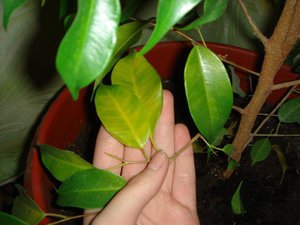 Also, soil depletion can be the cause of leaf shedding. Why is this happening? For example, if ficus Benjamin grows for a long period in the same land without transplanting, then it drains the earth over time... To avoid such a problem, you need to constantly feed the plant. For these purposes, liquid fertilizers are mainly used for decorative deciduous crops. It is also advisable to regularly pour fresh soil into the ficus pot.
Also, soil depletion can be the cause of leaf shedding. Why is this happening? For example, if ficus Benjamin grows for a long period in the same land without transplanting, then it drains the earth over time... To avoid such a problem, you need to constantly feed the plant. For these purposes, liquid fertilizers are mainly used for decorative deciduous crops. It is also advisable to regularly pour fresh soil into the ficus pot.
Ficus pests Benjamin photo
It is necessary each time to check the flower, whether such parasites as spider mites or scale insects have appeared on it. Why are they so dangerous? These insects suck out all the juice from the ficus, thereby weakening it. Daily rubbing of the leaves will help to avoid the appearance of such parasites.
Sometimes ficus Benjamin begins to shed its leaves due to damage by a shield... The female of this pest sits motionlessly on the plant. It covers the laid eggs and secretes a sticky secret that provokes the appearance of the fungus. It is not difficult to remove an insect from a leaf, however, it is not always possible to completely get rid of it, since it has a waxy shell that protects the shield from the action of insecticidal preparations.
You can remove this pest from the leaves with vodka or garlic infusion. The top layer of soil will also have to be removed, as insect larvae can remain in it. Moreover, the procedure is repeated several times every week until the scabbard disappears.
Benjamin's flower leaves may turn yellow with spider mite infestation... These small pests up to 1 mm in length are able to multiply rapidly in dry and warm conditions. You can suspect their appearance on a plant by yellow and white specks on the leaves. If nothing is done, then after a while the thinned and discolored parts of the plant increase, which leads to the death and shedding of foliage.
When Benjamin's ficus is affected by this parasite, it must be treated with phosphorus or sulfuric agents. It is recommended to alternate the preparations so that the ticks do not develop resistance to them. Moreover, the eggs of the pest are able to remain viable in the soil for several years. Getting rid of a spider mite is quite difficult. That is why it is better to control the humidity in the room with the flower, and immediately take action at the first symptoms of the disease.
The leaves can also fall off due to thrips. These parasites are capable of causing enormous damage to the plant.For them, the best room temperature is 20-25 degrees. Moreover, in dry air, they instantly multiply and can affect other flowers in the house... Such pests cause deformation not only of flowers, but also of the stem. You need to deal with it with insecticidal agents. It is enough to process the plant with them several times. To prevent the possible appearance of thrips, do not forget to spray the ficus tree and humidify the air in the room.
Preventive measures
Proper care at home for Benjamin's ficus depends on its health and appearance. For prevention purposes, it is important to follow some tips when growing a flower:
- In winter, you need to reduce watering and stop irrigating the ground if the temperature in the room does not exceed 10 degrees Celsius.
- In a room with a flower, you should maintain an optimal temperature of 20-25 degrees in summer and spring. In winter, a moderate temperature for a plant is considered to be about 16 degrees.
- Constant refreshing of ficus foliage by spraying or wiping with a damp sponge.
- It is necessary to put a flower pot in a room with sufficient lighting, but without exposure to sunlight. The best place for him is the windowsill on the east side of the house.
- Ficus requires moderate watering without waterlogging the soil, using warm water with a low chlorine content.
- The plant should be transplanted in the spring - a young one can be every year, and an adult - once every few years.
- Loosening the soil before watering, so that moisture does not stagnate, but is distributed evenly over the ground.
When growing a flower, it is necessary to use exclusively high-quality planting mixture, enriched with nutrients. If necessary, fertilizers can be added to improve the nutrition of the ficus.
Why do the leaves fall anyway?
Sometimes the above methods do not give any results, and the leaves continue to crumble. In this case, the reason for this may be rotten root system... Remove the ficus from the flowerpot, carefully peel the roots from the soil, and inspect them. When they look like gray strings, moreover, they are very slippery, then the diagnosis was confirmed. The damaged ficus is transplanted into new soil.
All rotten roots must be cut off, the same applies to dry and dead leaves. Then the root system should be soaked in a solution of potassium permanganate to disinfect it. The cut should dry well, after which you can cover it with foundation, coal powder or ground cinnamon. For transplanting, you will need dry land. Water the planted plant in the first days will have to be moderate.
